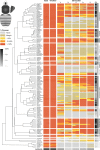The diversity, evolution, and development of setal morphologies in bumble bees (Hymenoptera: Apidae: Bombus spp.)
- PMID: 36573237
- PMCID: PMC9789693
- DOI: 10.7717/peerj.14555
The diversity, evolution, and development of setal morphologies in bumble bees (Hymenoptera: Apidae: Bombus spp.)
Abstract
Bumble bees are characterized by their thick setal pile that imparts aposematic color patterns often used for species-level identification. Like all bees, the single-celled setae of bumble bees are branched, an innovation thought important for pollen collection. To date no studies have quantified the types of setal morphologies and their distribution on these bees, information that can facilitate understanding of their adaptive ecological function. This study defines several major setal morphotypes in the common eastern bumble bee Bombus impatiens Cresson, revealing these setal types differ by location across the body. The positions of these types of setae are similar across individuals, castes, and sexes within species. We analyzed the distribution of the two most common setal types (plumose and spinulate) across the body dorsum of half of the described bumble bee species. This revealed consistently high density of plumose (long-branched) setae across bumble bees on the head and mesosoma, but considerable variation in the amount of metasomal plumosity. Variation on the metasoma shows strong phylogenetic signal at subgeneric and smaller group levels, making it a useful trait for species delimitation research, and plumosity has increased from early Bombus ancestors. The distribution of these setal types suggests these setae may serve several functions, including pollen-collecting and thermoregulatory roles, and probable mechanosensory functions. This study further examines how and when setae of the pile develop, evidence for mechanosensory function, and the timing of pigmentation as a foundation for future genetic and developmental research in these bees.
Keywords: Bee; Bombus; Development; Morphology; Pigmentation; Pollen; Pollination; Setae; Systematics.
© 2022 Hines et al.
Conflict of interest statement
The authors declare that they have no competing interests.
Figures






References
-
- Ågren L, Hallberg E. Flagellar sensilla of bumble bee males (Hymenopera, Apidae, Bombus) Apidologie. 1996;27(6):433–444. doi: 10.1051/apido:19960601. - DOI
-
- Alford DV. Bumblebees. London: Davis-Poynter; 1975.
-
- Benton T. Bumblebees: the natural history & identification of the species found in Britain. Vol. 98. Insch: Harper Uk; 2006.
-
- Chapman RF. The insects: structure and function. Fourth Edition. Cambridge: Cambridge University Press; 1998. p. 770.
Publication types
MeSH terms
LinkOut - more resources
Full Text Sources
Miscellaneous

